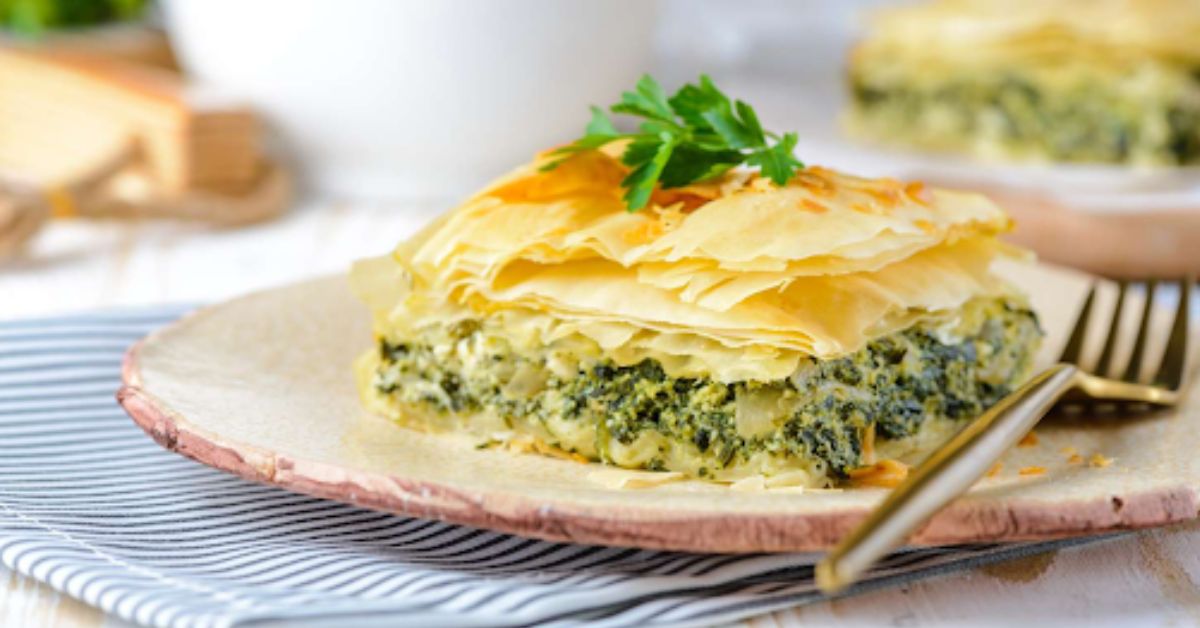Greek spinach pie, also known as spanakopita, is a classic dish that combines flaky phyllo pastry with a savory filling of spinach, herbs, and feta cheese. With its crispy layers and rich flavors, this dish is ideal for any meal, whether as a light lunch, appetizer, or side dish. This guide will walk you through each step of creating an authentic Greek spinach pie that’s sure to impress!
Ingredients for Greek Spinach Pie
To make an authentic Greek spinach pie, gather the following ingredients:
For the Filling:
- 1 lb fresh spinach (washed and chopped, or use frozen spinach, thawed and drained)
- 1 cup crumbled feta cheese
- 1/2 cup ricotta cheese (optional for added creaminess)
- 2-3 green onions (finely chopped)
- 1/4 cup fresh parsley (chopped)
- 1/4 cup fresh dill (chopped)
- 2-3 large eggs (beaten)
- Salt and pepper to taste
- 1/4 cup olive oil
For the Phyllo Pastry:
- 1 pack phyllo dough (thawed if frozen)
- 1/2 cup olive oil or melted butter (for brushing between phyllo layers)
Step 1: Prepare the Spinach Filling
In a large mixing bowl, combine the spinach, green onions, parsley, and dill. If using fresh spinach, wilt it down in a pan for a few minutes before combining. Add the crumbled feta cheese, ricotta cheese, and beaten eggs to the mixture. Stir well to incorporate the ingredients.
Season with salt and pepper, keeping in mind that feta is already salty, so add sparingly. The olive oil can be mixed into the filling to help keep it moist and flavorful.
Step 2: Prepare the Phyllo Dough
Phyllo dough can be delicate, so it’s best to work carefully. Place a clean, damp kitchen towel over the phyllo sheets while working to prevent them from drying out. Lightly brush a baking dish with olive oil or melted butter.
Step 3: Assemble the Spinach Pie
Layer the Phyllo Dough
- Place a sheet of phyllo dough at the bottom of the baking dish, gently pressing it into place. Brush the phyllo with olive oil or butter.
- Add another sheet, brush with oil, and continue this process until you have layered about 6-8 sheets, ensuring each one is coated.
Add the Spinach Filling
Spread the prepared spinach and cheese filling evenly over the layered phyllo. Ensure the filling is well-distributed so each slice of pie has a generous amount.
Top with More Phyllo
Place another sheet of phyllo on top of the filling, brush with oil, and continue layering and brushing each sheet until you’ve used about 6-8 more sheets on top. This will create a golden, crispy crust for the pie.
Step 4: Bake the Spinach Pie
Preheat your oven to 350°F (175°C). Use a sharp knife to score the top of the pie into squares or triangles. This will make it easier to cut once baked and prevents the top from cracking.
Place the pie in the oven and bake for 45-50 minutes, or until the top is golden brown and the filling is set. Keep an eye on the pie to avoid over-baking.
Step 5: Serve Your Greek Spinach Pie
Allow the spinach pie to cool for about 10 minutes before serving. This makes it easier to cut and helps the flavors meld together. Serve warm as an appetizer, main dish, or side. Greek spinach pie pairs beautifully with a fresh Greek salad, olives, or even a dollop of Greek yogurt.
Final Tips for Making Greek Spinach Pie
- Use quality phyllo dough for a flakier result.
- Experiment with herbs like mint for added depth.
- Make it ahead as spanakopita reheats well and tastes even better the next day.
With these steps, you’ll have a delicious, authentic Greek spinach pie that’s both impressive and packed with flavor.










